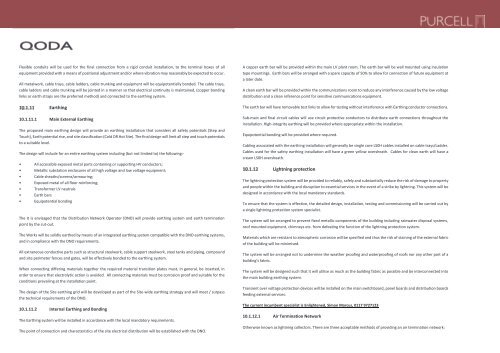St Mary Redcliffe Project 450 RIBA 2 Stage End Report
You also want an ePaper? Increase the reach of your titles
YUMPU automatically turns print PDFs into web optimized ePapers that Google loves.
Flexible conduits will be used for the final connection from a rigid conduit installation, to the terminal boxes of all<br />
equipment provided with a means of positional adjustment and/or where vibration may reasonably be expected to occur.<br />
All metalwork, cable trays, cable ladders, cable trunking and equipment will be equipotentially bonded. The cable trays,<br />
cable ladders and cable trunking will be jointed in a manner so that electrical continuity is maintained, (copper bonding<br />
links or earth straps are the preferred method) and connected to the earthing system.<br />
Earthing<br />
10.1.11.1 Main External Earthing<br />
The proposed main earthing design will provide an earthing installation that considers all safety potentials (<strong>St</strong>ep and<br />
Touch), Earth potential rise, and site classification (Cold OR Hot Site). The final design will limit all step and touch potentials<br />
to a suitable level.<br />
The design will include for an entire earthing system including (but not limited to) the following:-<br />
• All accessible exposed metal parts containing or supporting HV conductors;<br />
• Metallic substation enclosures of all high voltage and low voltage equipment;<br />
• Cable sheaths/screens/armouring;<br />
• Exposed metal of all floor reinforcing;<br />
• Transformer LV neutrals<br />
• Earth bars<br />
• Equipotential bonding<br />
The It is envisaged that the Distribution Network Operator (DNO) will provide earthing system and earth termination<br />
point by the cut-out.<br />
The Works will be solidly earthed by means of an integrated earthing system compatible with the DNO earthing systems,<br />
and in compliance with the DNO requirements.<br />
All extraneous conductive parts such as structural steelwork, cable support steelwork, steel tanks and piping, compound<br />
and site perimeter fences and gates, will be effectively bonded to the earthing system.<br />
When connecting differing materials together the required material transition plates must, in general, be inserted, in<br />
order to ensure that electrolytic action is avoided. All connecting materials must be corrosion proof and suitable for the<br />
conditions prevailing at the installation point.<br />
The design of the Site earthing grid will be developed as part of the Site-wide earthing strategy and will meet / surpass<br />
the technical requirements of the DNO.<br />
10.1.11.2 Internal Earthing and Bonding<br />
The Earthing system will be installed in accordance with the local mandatory requirements.<br />
The point of connection and characteristics of the site electrical distribution will be established with the DNO.<br />
A copper earth bar will be provided within the main LV plant room. The earth bar will be wall mounted using insulation<br />
type mountings. Earth bars will be arranged with a spare capacity of 50% to allow for connection of future equipment at<br />
a later date.<br />
A clean earth bar will be provided within the communications room to reduce any interference caused by the low voltage<br />
distribution and a clean reference point for sensitive communications equipment.<br />
The earth bar will have removable test links to allow for testing without interference with Earthing conductor connections.<br />
Sub-main and final circuit cables will use circuit protective conductors to distribute earth connections throughout the<br />
installation. High-integrity earthing will be provided where appropriate within the installation.<br />
Equipotential bonding will be provided where required.<br />
Cabling associated with the earthing installation will generally be single core LS0H cables installed on cable trays/Ladder.<br />
Cables used for the safety earthing installation will have a green yellow oversheath. Cables for clean earth will have a<br />
cream LS0H oversheath.<br />
Lightning protection<br />
The lightning protection system will be provided to reliably, safely and substantially reduce the risk of damage to property<br />
and people within the building and disruption to essential services in the event of a strike by lightning. This system will be<br />
designed in accordance with the local mandatory standards.<br />
To ensure that the system is effective, the detailed design, installation, testing and commissioning will be carried out by<br />
a single lightning protection system specialist.<br />
The system will be arranged to prevent fixed metallic components of the building including rainwater disposal systems,<br />
roof mounted equipment, chimneys etc. from defeating the function of the lightning protection system.<br />
Materials which are resistant to atmospheric corrosion will be specified and thus the risk of staining of the external fabric<br />
of the building will be minimised.<br />
The system will be arranged not to undermine the weather proofing and waterproofing of roofs nor any other part of a<br />
building’s fabric.<br />
The system will be designed such that it will utilise as much as the building fabric as possible and be interconnected into<br />
the main building earthing system.<br />
Transient over voltage protection devices will be installed on the main switchboard, panel boards and distribution boards<br />
feeding external services.<br />
The current incumbent specialist is Enlightened, Simon Marcus, 0117 9727123<br />
10.1.12.1 Air Termination Network<br />
Otherwise known as lightning collectors. There are three acceptable methods of providing an air termination network:<br />
1563.R1 – <strong>St</strong>age 2 report Page 22 of 29


















